Public Service Enterprise Group Bundle
How Does Public Service Enterprise Group Thrive in the Energy Sector?
Public Service Enterprise Group (PSEG), a leading energy company, is a powerhouse in the utility sector, particularly in the northeastern and mid-Atlantic regions. With roots tracing back to 1903 and boasting approximately $54.6 billion in assets as of late 2024, PSEG is strategically positioned to navigate the evolving energy landscape. Its focus on infrastructure upgrades, decarbonization, and meeting customer needs highlights its critical role in today's world.
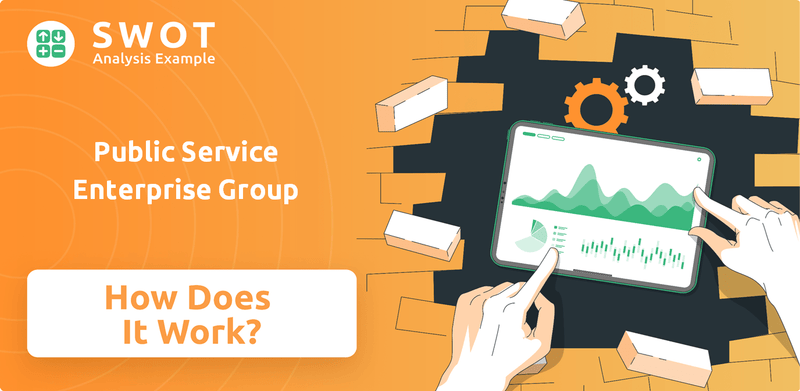
PSEG's impressive first-quarter 2025 results, with a 9.2% increase in non-GAAP operating earnings and a 16.7% surge in revenue, underscore its financial strength. This strong performance, fueled by regulated utility growth and nuclear reliability, supports the company's optimistic full-year guidance. To gain a deeper understanding of PSEG, explore the Public Service Enterprise Group SWOT Analysis to uncover its strengths, weaknesses, opportunities, and threats.
What Are the Key Operations Driving Public Service Enterprise Group’s Success?
The Public Service Enterprise Group (PSEG) creates and delivers value through its main subsidiaries: Public Service Electric & Gas Co. (PSE&G) and PSEG Power. PSE&G operates as a regulated electric and gas utility, serving approximately 2.4 million electric and 1.9 million natural gas customers in New Jersey. PSEG Power functions as an independent power producer, integrating its nuclear generating assets with fuel supply, energy trading, and risk management.
PSE&G focuses on infrastructure modernization, including upgrading electric and gas systems to enhance storm resiliency, improve local reliability, and reduce methane leaks. Their capital investment plan for 2025 through 2029 is projected to be between $21 billion to $24 billion for regulated activities, aimed at meeting growing energy demand and supporting state clean energy goals. PSEG's nuclear fleet provides carbon-free power, achieving a 99.9% capacity factor in Q1 2025 and supplying 8.4 terawatt-hours of energy.
PSEG's supply chain and distribution networks are integral to its operations, ensuring reliable energy delivery. The company's commitment to operational excellence is evidenced by its 23rd consecutive ReliabilityOne® Award for Outstanding Metropolitan Service Area Reliability Performance in the Mid-Atlantic region in 2024. The predominantly regulated business model insulates it from market volatility, and its investments in clean energy initiatives align with New Jersey's clean energy targets, such as the Clean Energy Future - Energy Efficiency II Program, which represents approximately $2.9 billion in approved spending over six years.
PSE&G focuses on upgrading electric and gas systems. They aim to enhance storm resiliency and improve local reliability. Their capital investment plan is between $21 billion to $24 billion from 2025 to 2029.
PSEG Power integrates nuclear generating assets. It focuses on fuel supply, energy trading, and risk management. The nuclear fleet supplied 8.4 terawatt-hours of energy in Q1 2025.
PSEG's value comes from reliable energy delivery. It is supported by its regulated business model. They invest in clean energy initiatives, aligning with state goals.
Customers benefit from reduced carbon emissions and lower energy bills. The company's clean energy efforts create job opportunities. PSEG's focus is on delivering reliable energy.
PSEG’s operational effectiveness is demonstrated through its ReliabilityOne® Award and clean energy investments. The company's nuclear fleet plays a significant role in providing carbon-free power. The company's focus on infrastructure upgrades further enhances its operational efficiency.
- 2.4 million electric customers served by PSE&G.
- $21-$24 billion capital investment plan (2025-2029).
- 99.9% nuclear fleet capacity factor in Q1 2025.
- 8.4 terawatt-hours of energy supplied by nuclear generation.
Public Service Enterprise Group SWOT Analysis
- Complete SWOT Breakdown
- Fully Customizable
- Editable in Excel & Word
- Professional Formatting
- Investor-Ready Format
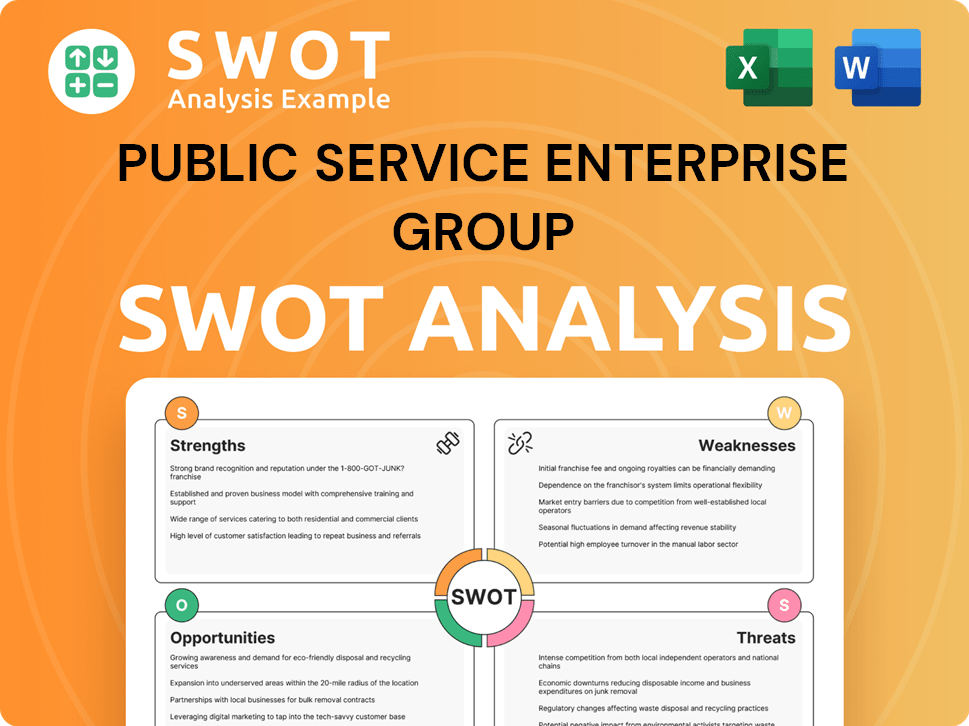
How Does Public Service Enterprise Group Make Money?
The primary revenue streams for Public Service Enterprise Group (PSEG) come from its regulated utility business, Public Service Electric & Gas Co. (PSE&G), and its power generation segment, PSEG Power. PSE&G's earnings are driven by base distribution rates and infrastructure investments, while PSEG Power benefits from nuclear generation assets and federal tax credits. These diversified income sources contribute to the company's financial stability and growth.
In Q1 2025, PSE&G's non-GAAP operating earnings reached $546 million, an increase from $488 million in Q1 2024. This growth was supported by new electric and gas base distribution rates implemented on October 15, 2024, and the recovery of over $3 billion in prior capital investments. PSEG Power & Other reported non-GAAP operating earnings of $172 million in Q1 2025, reflecting the consistent energy output from its nuclear fleet, which achieved a 99.9% capacity factor during the same period.
PSEG's monetization strategies are centered around its regulated business model, which allows for guaranteed returns on capital investments through rate base increases. The company plans a total capital program of $22.5 billion to $26 billion for 2025-2029, with over 90% allocated to regulated activities. This investment is expected to support PSE&G's rate base compound annual growth rate (CAGR) of 6%-7.5% over the same period. Additionally, the Clean Energy Future - Energy Efficiency II Program, with approximately $2.9 billion in approved spending, aims to reduce customer bills and emissions, while also creating revenue opportunities through program implementation.
PSEG's financial success is built on a foundation of strategic investments and operational efficiency. Here's a closer look at the key elements:
- Regulated Utility Business: PSE&G's base distribution rates and infrastructure investments provide a stable revenue stream.
- Power Generation: PSEG Power's nuclear generation assets, supported by federal tax credits, contribute significantly to earnings.
- Capital Investments: The company's extensive capital program, totaling $22.5 billion to $26 billion from 2025-2029, focuses on regulated activities.
- Rate Base Growth: PSE&G's rate base is projected to grow at a CAGR of 6%-7.5% from 2025-2029, driven by capital investments.
- Energy Efficiency Programs: The Clean Energy Future - Energy Efficiency II Program generates revenue while reducing customer bills and emissions.
Public Service Enterprise Group PESTLE Analysis
- Covers All 6 PESTLE Categories
- No Research Needed – Save Hours of Work
- Built by Experts, Trusted by Consultants
- Instant Download, Ready to Use
- 100% Editable, Fully Customizable
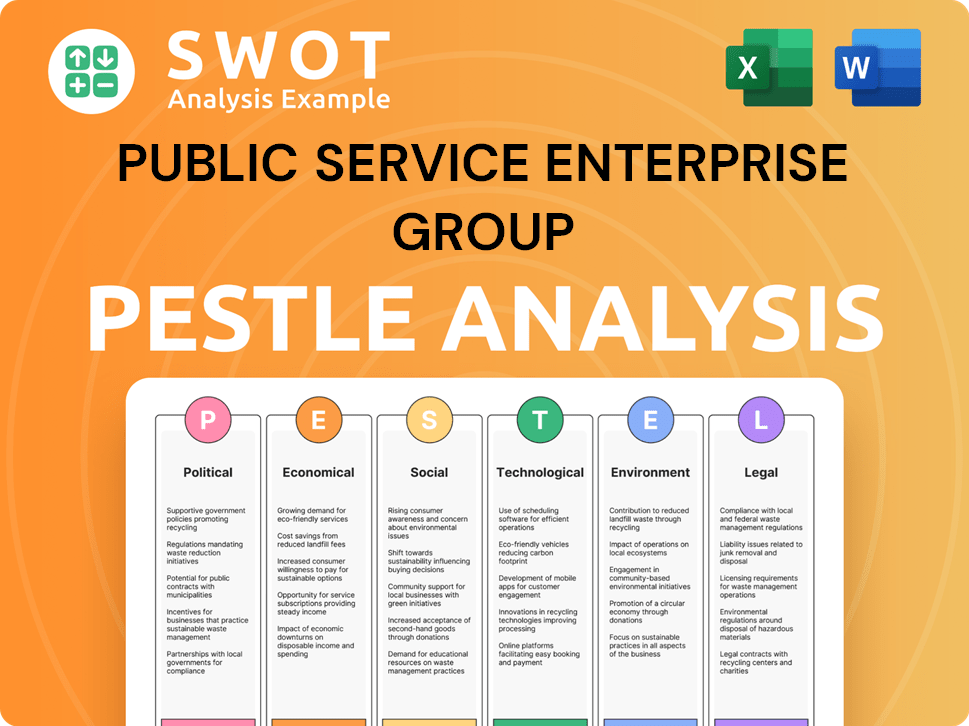
Which Strategic Decisions Have Shaped Public Service Enterprise Group’s Business Model?
Public Service Enterprise Group (PSEG) has undergone significant transformations and strategic adjustments, shaping its operational landscape and financial performance. A major decision in 2024 was the resolution of key regulatory filings, including the base distribution rate case for PSE&G and the Clean Energy Future - Energy Efficiency II (CEF-EE II) initiative. This provides approximately $2.9 billion in approved spending over a six-year period starting January 2025, enhancing earnings predictability and stability. Additionally, PSEG has strategically exited the offshore wind generation sector while maintaining its focus on its carbon-free nuclear fleet.
Operational challenges, such as extreme weather events, including severe cold spells in Q1 2025, have tested PSEG's resilience. Despite these difficulties, the company maintained high levels of reliability with zero significant outages, demonstrating the robustness of its infrastructure. As of March 31, 2025, PSE&G was also addressing remediation costs for 38 former manufactured gas plant (MGP) sites, with estimated costs of $199-$224 million to complete all sites.
PSEG's commitment to clean energy and infrastructure modernization aligns with state and federal energy transition policies, providing favorable regulatory tailwinds and tax incentives. Its long-standing operational excellence is further demonstrated by its 23rd consecutive ReliabilityOne® Award in 2024 and its recognition as a top utility in customer satisfaction by J.D. Power. The company continues to adapt to new trends through initiatives like the Clean Energy Future programs, including investments in battery storage and solar farms, and exploring opportunities for increasing nuclear plant capacity. For a deeper dive into the company's approach, explore the Marketing Strategy of Public Service Enterprise Group.
PSEG's strategic moves include settling major regulatory filings and exiting offshore wind generation. The company's focus remains on its carbon-free nuclear fleet, which has seen enhanced economics due to federal tax credits. These moves contribute to earnings stability and predictable growth paths.
The company's substantial capital investment plan of $22.5 billion to $26 billion for 2025-2029, with over 90% allocated to regulated activities, is a key driver for future growth. This plan can be funded without issuing new equity, a significant advantage in the current interest rate environment.
PSEG's predominantly regulated business model provides stability and predictable returns, insulating it from market volatility. The company's commitment to clean energy and infrastructure modernization aligns with state and federal energy transition policies, providing favorable regulatory tailwinds and tax incentives.
PSEG faces operational challenges such as extreme weather events, including the severe cold spells experienced in Q1 2025. Despite these challenges, the company maintained high levels of reliability with zero significant outages, demonstrating the resilience of its infrastructure. As of March 31, 2025, PSE&G was also addressing remediation costs for 38 former manufactured gas plant (MGP) sites.
PSEG's strengths include a stable, regulated business model and a significant capital investment plan. The company is focused on clean energy, infrastructure modernization, and operational excellence. PSEG is also investing in battery storage, solar farms, and exploring nuclear plant capacity expansion.
- Reliability: Maintained high levels of reliability with zero significant outages despite operational challenges.
- Financial Stability: The capital investment plan can be funded without issuing new equity.
- Clean Energy Focus: Commitment to clean energy initiatives, including battery storage and solar farms.
- Regulatory Support: Aligned with state and federal energy transition policies, providing favorable regulatory tailwinds.
Public Service Enterprise Group Business Model Canvas
- Complete 9-Block Business Model Canvas
- Effortlessly Communicate Your Business Strategy
- Investor-Ready BMC Format
- 100% Editable and Customizable
- Clear and Structured Layout
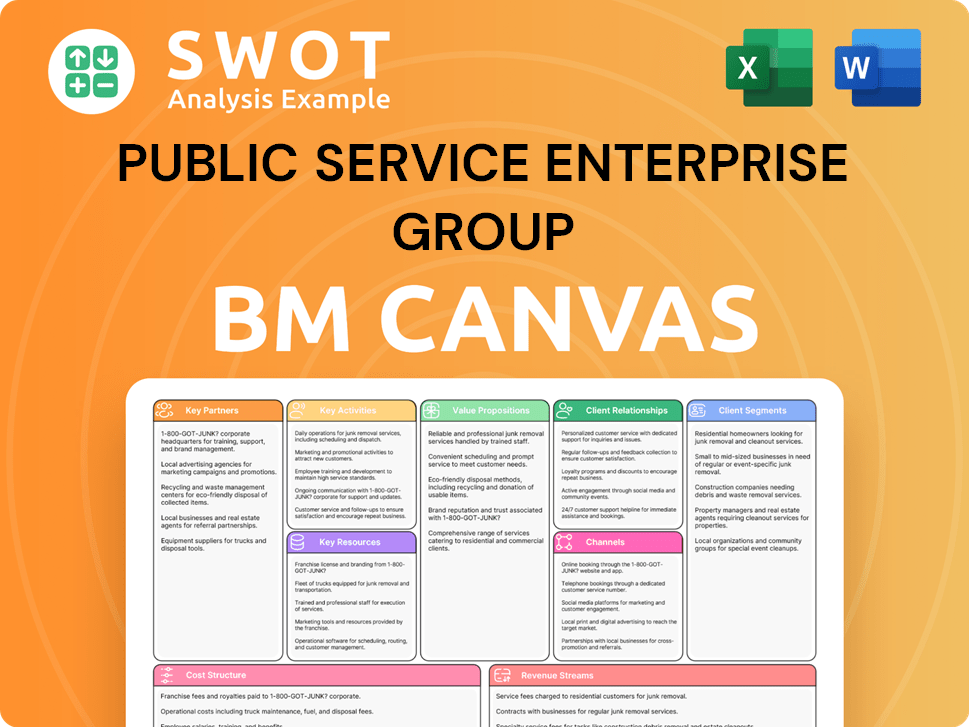
How Is Public Service Enterprise Group Positioning Itself for Continued Success?
The Public Service Enterprise Group (PSEG) holds a strong position as a predominantly regulated infrastructure company. It operates New Jersey's largest transmission and distribution utility. As of December 2024, the PSEG company served approximately 2.4 million electric and 1.9 million natural gas customers in New Jersey. The company's nuclear facilities contribute significantly to the state's energy mix, providing 85% of New Jersey's carbon-free power generation and about 40% of its total energy.
Despite its robust position, PSEG faces several key risks and headwinds. Regulatory changes, such as the declining Solar Renewable Energy Credit (SREC) prices in New Jersey, could impact margins. The company also navigates risks associated with operating nuclear facilities, including increased fuel storage costs and regulatory compliance. Furthermore, the ongoing assessment and remediation of former manufactured gas plant (MGP) sites present potential costs, with an estimated $199-$224 million to complete all 38 sites as of March 31, 2025. Cybersecurity threats to grid modernization efforts also pose a risk.
PSEG is a leading energy company, primarily focused on regulated infrastructure. It is the largest transmission and distribution utility in New Jersey. This position provides a stable foundation for operations and investment.
The company faces regulatory and operational risks. Declining SREC prices and nuclear facility operations present challenges. Cybersecurity threats and MGP site remediation also pose financial and operational risks.
PSEG plans significant investments in infrastructure. The capital program for 2025-2029 is projected to be between $22.5 billion and $26 billion. The company aims for a 5%-7% non-GAAP earnings growth for 2025-2029.
PSEG is focused on infrastructure modernization and renewable energy. They are also pursuing nuclear plant capacity increases. The company is committed to net-zero carbon emissions by 2030.
PSEG's future relies on strategic investments and operational improvements. The company is focused on expanding its infrastructure and increasing its power generation capacity.
- Infrastructure Modernization: Significant investments in transmission and distribution systems.
- Renewable Energy: Expansion of renewable energy projects to meet decarbonization goals.
- Nuclear Capacity: Enhancements to existing nuclear plants to increase output.
- Financial Targets: Aiming for consistent earnings growth through strategic initiatives.
Public Service Enterprise Group Porter's Five Forces Analysis
- Covers All 5 Competitive Forces in Detail
- Structured for Consultants, Students, and Founders
- 100% Editable in Microsoft Word & Excel
- Instant Digital Download – Use Immediately
- Compatible with Mac & PC – Fully Unlocked
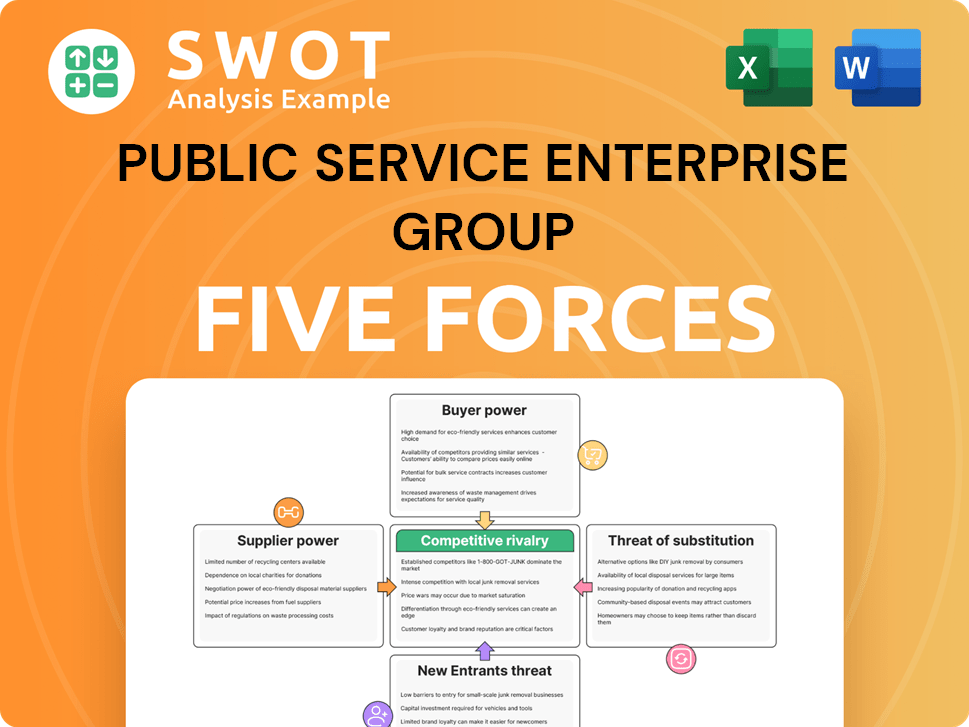
Related Blogs
- What are Mission Vision & Core Values of Public Service Enterprise Group Company?
- What is Competitive Landscape of Public Service Enterprise Group Company?
- What is Growth Strategy and Future Prospects of Public Service Enterprise Group Company?
- What is Sales and Marketing Strategy of Public Service Enterprise Group Company?
- What is Brief History of Public Service Enterprise Group Company?
- Who Owns Public Service Enterprise Group Company?
- What is Customer Demographics and Target Market of Public Service Enterprise Group Company?
Disclaimer
All information, articles, and product details provided on this website are for general informational and educational purposes only. We do not claim any ownership over, nor do we intend to infringe upon, any trademarks, copyrights, logos, brand names, or other intellectual property mentioned or depicted on this site. Such intellectual property remains the property of its respective owners, and any references here are made solely for identification or informational purposes, without implying any affiliation, endorsement, or partnership.
We make no representations or warranties, express or implied, regarding the accuracy, completeness, or suitability of any content or products presented. Nothing on this website should be construed as legal, tax, investment, financial, medical, or other professional advice. In addition, no part of this site—including articles or product references—constitutes a solicitation, recommendation, endorsement, advertisement, or offer to buy or sell any securities, franchises, or other financial instruments, particularly in jurisdictions where such activity would be unlawful.
All content is of a general nature and may not address the specific circumstances of any individual or entity. It is not a substitute for professional advice or services. Any actions you take based on the information provided here are strictly at your own risk. You accept full responsibility for any decisions or outcomes arising from your use of this website and agree to release us from any liability in connection with your use of, or reliance upon, the content or products found herein.